

The United States SPECIALIST




“China Clay”— Kaolin Content in the First, Second, Third, and Fourth Bureau Issues

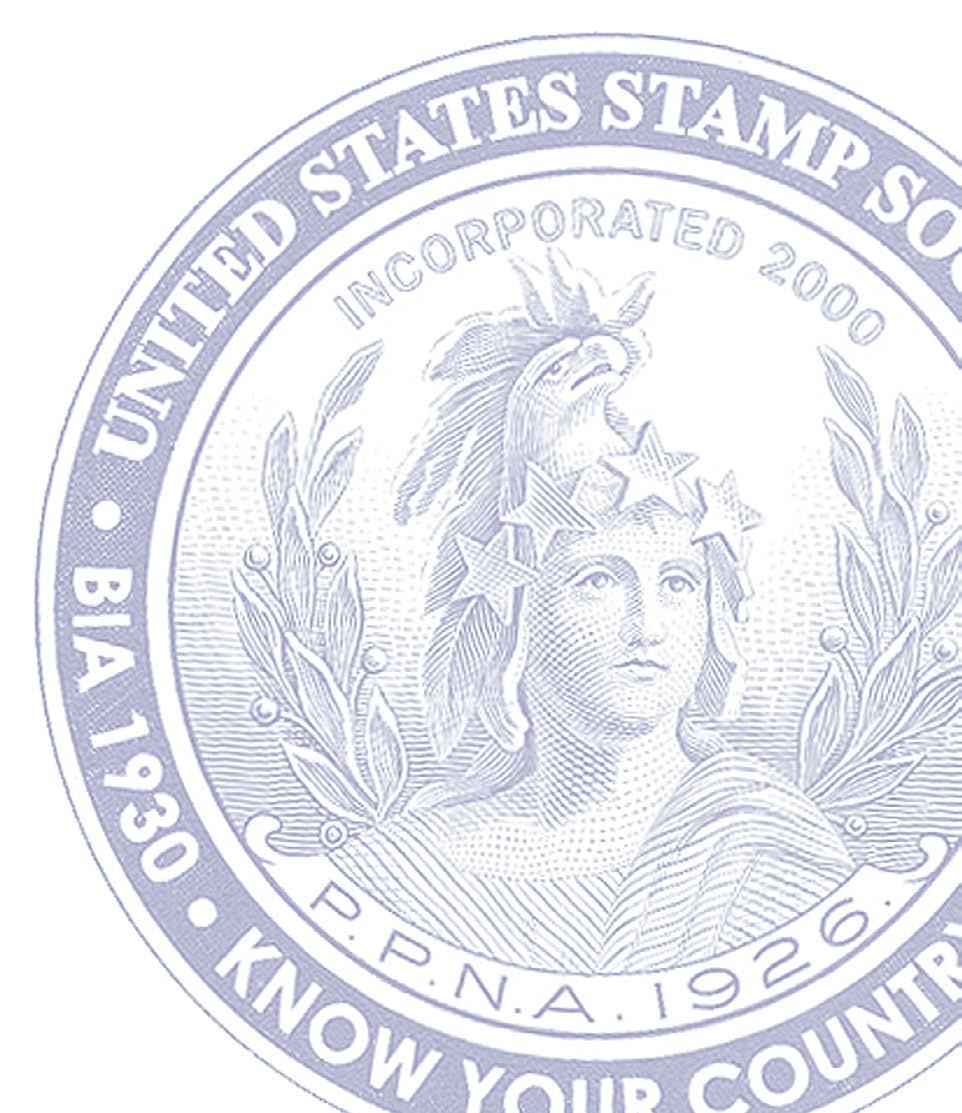
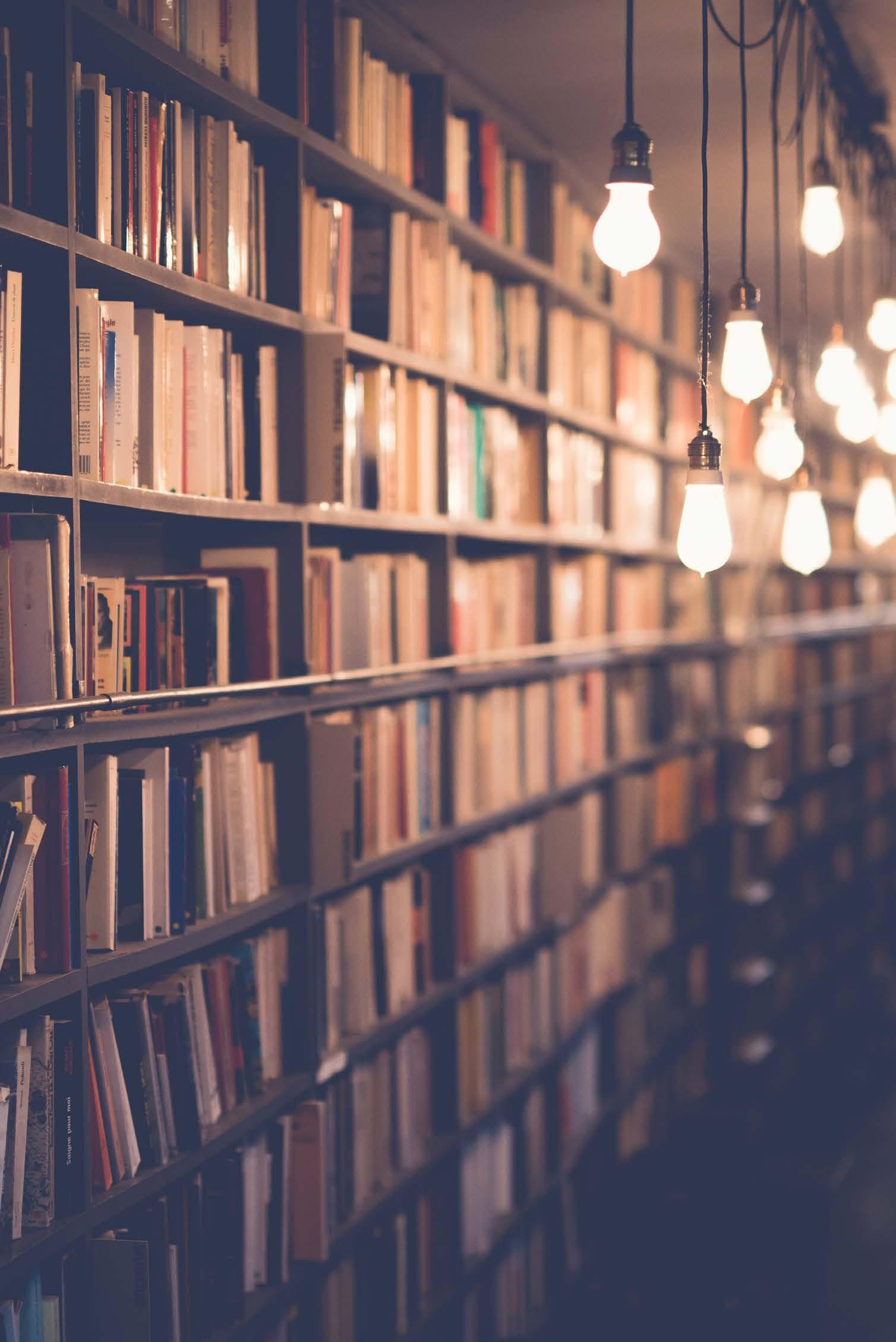


Encyclopedia of United States Stamps and Stamp Collecting Second Edition
Edited by Rodney A. Juell, Lynn R. Batdorf and Steven J. Rod
Hardbound, 769 pages. $35 members, $40 nonmembers. Visit the website for shipping costs.

United States Savings Stamps by Harry K. Charles, Jr.
A presentation of the United States Postal and Treasury Savings Stamp Systems, the stamps and their closely associated collection cards and booklets, and Official Mail stamps and stationery.
Softbound, 253 pages.
Postpaid: $25 members, $28 nonmembers. Visit the website for shipping costs.
Order from: USSS, P.O. Box 1602, Hockessin, DE 19707-5602 or online at: www.usstamps.org/store/

The United States SPECIALIST
the journal of the United States Stamp Society
VOLUME 96, NUMBER 6 J UNE 2025
WHOLE NUMBER 1144
An association of collectors to promote the study of all postage and revenue stamps and stamped paper of the United States and US-administered areas produced by the Bureau of Engraving and Printing and other contract printers. American Philatelic Society Affiliate No. 150
Prologue
264 Vintage Photo of the Month by Rodney A. Juell

Epilogue
284 Plate Number Report by Kim D. Johnson
287 Executive Secretary’s Report by Robert Rufe
288 Classified Advertising
288 Index of Advertisers
Andrew S. Kelley, Editor 9038 East 25th Drive Denver, CO 80238 (720) 839-5848
email: editor@usstamps.org www.usstamps.org
Manuscripts, publications for review, and all advertising including classifieds, should be sent to the Editor at the address above.
Forms close on the 20th of the second month preceding the month of publication, as February 20 for the April edition.
The United States Specialist (ISSN 0164-923X) is published monthly January through December by
Features
244 Great Americans Issue, Part XIII— Issues Printed on Uncoated Prephosphored Paper by Jay Stotts
250 US Stamp Booklet Cashier Scanner Card by Bob Trachimowicz
253 FDR and the 1927 Lindbergh Airmail Stamp, Part I by Paul M. Holland
262 Why the Lilac Shade of Scott 376 Is Definitely Worth Looking For by Kevin G. Lowther
266 Discovery: New Precancel City for Scott 1056 by Roland Austin
268 The Coming and Going of China Clay in BEP Printing Paper: Kaolin Content in the 2¢ Stamps of the First, Second, Third, and Fourth Bureau Issues by Harry G. Brittain, PhD
the United States Stamp Society, Inc., P.O. Box 1602, Hockessin, DE 19707-5602. Membership in the United States $25. North America $40; all others $65. Single copy $2. Periodical postage paid at Hockessin, DE, and at additional entry offices. Printed in USA.
Copyright ©2025United States Stamp Society, Inc. All rights reserved. Opinions expressed by authors are their own and do not necessarily reflect those of the United States Stamp Society, its officers, or staff.
Correspondence concerning business affairs of the Society, including membership and changes in address, should be addressed to the Executive Secretary, PO Box 1602, Hockessin, DE 19707-5602.
Postmaster: Send address changes to U.S.S.S., P.O. Box 1602, Hockessin, DE 19707-5602.

The United States Specialist
Founded 1930 as The Bureau Specialist
EDITOR
ANDREW S. KELLEY
9038 East 25th Drive Denver, CO 80238 email: editor@usstamps.org
United States Stamp Society Bureau Issues Association, Inc.
P.O. Box 1602 Hockessin, DE 19707-5602
CHAIRMAN
Roger S. Brody
P.O. Box 5836 Somerset, NJ 08875-5836 email: brody@usstamps.org
PRESIDENT
Nicholas Lombardi
P.O. Box 1005 Mountainside, NJ 07092 email: 8605@comcast.net
VICE PRESIDENT
Jeffrey Shapiro
P.O. Box 3211 Fayville, MA 01745-3211 email: coverlover@gmail.com
SECRETARY
Joel Cohen
10703 Kings Riding Way, Unit T-1 Rockville, MD 20852-5420 email: cohenji@comcast.net
TREASURER
David S. Sugar 4045 N. Harvard Ave. Arlington Heights, IL 60004 email: david-sugar@wsdd.com
GOVERNORS
Lynn Batdorf
Kim Johnson
Mike Lampson
Leonard Piszkiewicz
James Robinson
Robert Rose
Rod Juell
Gregory Shoults
David Steidley
Jay Stotts
Steven Unkrich
EXECUTIVE
SECRETARY
Robert Rufe
P.O. Box 1602
Hockessin, DE 19707-5602 email: execsecretary@usstamps.org
— Committees — AWARDS
Denise Stotts
email: stottsjd@swbell.net
BOOKLETS & BOOKLET PANES
Michael O. Perry
P.O. Box 1194, Rainier, OR 97048 email: MOPerry@mac.com
DURLAND EDITOR
Kim D. Johnson
310 E N 3rd Street, Georgetown, IL 61846 email: westhome1@aol.com
ESSAY-PROOF
James Patterson
1850 North Central Avenue, No. 1400 Phoenix, AZ 85004 email: jhpatterson@yahoo.com
EXHIBIT PDFs
Chris Steenerson
P.O. Box 1818
Westminster, CO 80038-1818
email: Chris@RxStamps.com
FARLEY ERA
Paul M. Holland
email: pholland.thorleaf@gmail.com
FOURTH BUREAU ISSUE
Jay B. Stotts email: stottsjd@swbell.net
LIBERTY SERIES
Roland Austin
P.O. Box 2641, Stillwater, OK 74076-2641 email: RAustin13@aol.com
MARGINAL MARKINGS
Chris Steenerson
P.O. Box 1818 Westminster, CO 80038-1818 email: Chris@RxStamps.com
MODERN POSTAL HISTORY
Douglas B. Quine P.O. Box 153, Bethel, CT 06801-0153 email: usss2010@quine.org
PLATE NUMBER & CHECKLIST SERVICE
Kim D. Johnson
310 E N 3rd Street, Georgetown, IL 61846 email: westhome1@aol.com
PRECANCELS
Lynn R. Batdorf 6005 Kingsford Road, Bethesda, MD 20817 email: hollykids@comcast.net
PRESIDENTIAL ERA
Jeffrey Shapiro
P.O. Box 3211, Fayville, MA 01745-3211
RECRUITING
Steven Crippe
P.O. Box 308, Palmer, TX 75152 email: scrippe@gmail.com
REVENUE ISSUES
Peter Martin
P.O. Box 6074, Fredericksburg, VA 22403 email: pmartin2525@yahoo.com
SECOND BUREAU ISSUE
Nicholas Lombardi
P.O. Box 1005, Mountainside, NJ 07092
VENDING AND AFFIXING MACHINE PERFORATIONS
Dan Ryterband 40 Carolyn Place, Chappaqua, NY 10514 email: djryterband@fwcook.com
WASHINGTON-FRANKLIN
HEAD ISSUES (Co-Chairmen)
Greg Shoults 11248 Frederick Lane Twinsburg, OH 44087 email: coilcollector@hotmail.com
Andrew S. Kelley 9038 E 25th Dr, Denver, CO 80238 email: stamps@andrewkelley.net
WEBMASTER
Mike Lampson
P.O. Box 471963, Charlotte, NC 28247 email: lampson@usstamps.org
— Study Groups — DUMMY STAMPS
Terry R. Scott
P.O. Box 10406, Napa, CA 94581 email: terryrscott@comcast.net
FIRST BUREAU ISSUE [open]
LUMINESCENCE
Wayne L. Youngblood 705 Forest Glen Circle, Prairie du Sac WI 53578 email: wystamps@gmail.com
OVERRUN COUNTRIES SERIES
Thomas Schilling
P.O. Box 432, New Lisbon, NJ 08064-0432 email: cbtkschilling@yahoo.com
PROMINENT AMERICANS AND AMERICANA SERIES
Ron Blanks
P.O. Box 9282, Chesapeake VA 23321 email: rblanks_stamps@yahoo.com
REGISTERED MAIL
Mike Ludeman
P.O. Box 2024, Denton, Texas 76202-2024 email: mike@ludeman.net


Great Americans Issue Part XIII— Issues Printed on Uncoated Prephosphored Paper
by Jay Stotts
USSS #10921 | m stottsjd@swbell.net
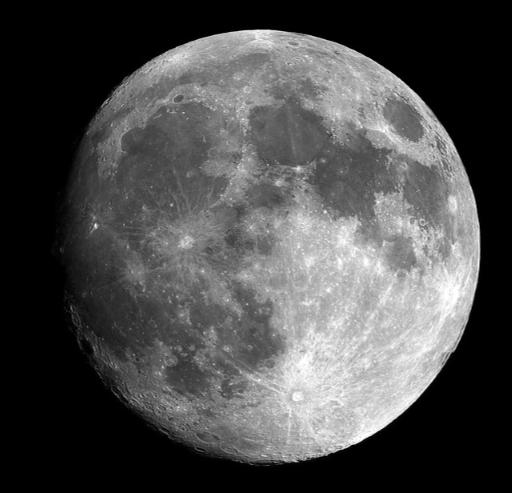
In the previous part of this series, we explained the switch that the Bureau of Engraving and Printing (BEP) made from printing stamps and then surface printing a phosphor compound on top of the stamp images to the practice of using coated prephosphored paper. This change lasted less than a year before the Bureau made another paper change.
In 1992, the BEP started using what can be termed as uncoated prephosphored paper. With the coated prephosphored paper, the phosphor compound was mixed with a coating substance and then applied to the paper, producing a smooth, solid appearance when viewing the stamps under shortwave ultraviolet light.
We’ll speculate here that the cost of producing uncoated prephosphored paper was slightly less than that of producing coated prephosphored paper because the coating compound was eliminated. The Bureau was always interested in reducing costs, so the uncoated prephosphored paper may have been financially appealing.
The Great Americans
Figure 1. Full Moon.
Viewing Mottled Prephosphored Paper
In manufacturing the uncoated prephosphored paper, the phosphor compound was not mixed with a coating compound but was applied directly to the paper. Without the coating compound, the paper surface was rough and uneven. The phosphor compound spread unevenly along the surface of the paper. Under shortwave ultraviolet light, the phosphor will appear very spotty and uneven. The term the philatelic community has adopted for this appearance is “mottled.”
To provide an analogy for the mottled appearance, consider the appearance of the surface of the moon, as shown in Figure 1. The smoother surfaces of the moon reflect sunlight evenly, while the rougher surfaces disperse the light unevenly and appear darker. When an uneven appearance of lighter and darker areas appears under shortwave ultraviolet light, the “mottled” appearance indicates that the stamp was printed on uncoated prephosphored paper.
50¢ Chester Nimitz Stamp

The 50¢ Chester Nimitz was printed on its third different press at the Bureau in 1992. It debuted as an I-8 Press issue in 1985 and later as an A Press issue in 1986. A new sleeve, Sleeve 3 (see Figure 2.), was prepared for the C to F family of presses. Bureau records indicate that Sleeve 3 was certified on July 8, 1991. The first stamps printed from this sleeve were printed with overall tagging, so this printing helps us determine that solid prephosphor-coated paper probably was limited to one press at the Bureau at first. In the previous part of this series, we wrote that the 23¢ Mary Cassatt stamp was first reported as printed on coated prephosphored paper on May 24, 1991.
Sleeve 3 printings of the 50¢ Nimitz stamp next appeared on uncoated prephosphored paper with a mottled appearance. The new variety is listed as number 1869e in the Scott Specialized Catalogue. The paper is reported as high bright with a bluish-white appearance when viewed under longwave ultraviolet light. The gum is shiny but not striated.
Additional Reissues on Uncoated Prephosphored Paper
Several popular values were printed again from 1992 through 1994, now on uncoated prephosphored paper. The United States Postal Service (USPS) did not regard such issues as “new issues,” so it didn’t provide first day of issue information. Because we can’t positively identify issue dates, the order of the values listed below may not reflect the chronological order of appearance.
We’ll start with the 23¢ Mary Cassatt stamp. The rate paid the fee for each additional ounce on domestic letters, so it was in high demand, and a new sleeve, Sleeve 3, was produced for the C to F family of presses. The uncoated paper variety was produced from
Figure 2. Nimitz plate block printed from Sleeve 3.
this sleeve. This variety is reported as having high bright paper characteristics and shiny gum. Figure 3 shows a Sleeve 3 plate block.
The 10¢ Red Cloud stamp appeared on uncoated prephosphored paper, and reports indicate that it was first noticed by the collecting community in the summer of 1994. It has shiny gum that is striated vertically. It was printed from Sleeve 2, the same sleeve used previously from the C to F family of presses for both overall tagged and solid-appearing prephosphor paper. When asked, the Postal Service answered that this variety was printed in late 1993.

The $1 Johns Hopkins stamp, which paid the $1 return receipt fee and the certified mail fee, had additional printings on uncoated prephosphored paper. Sleeve 2, as previously introduced with the coated paper printing, was used for this issue. The paper appears high bright and fluoresces bluish-white under longwave ultraviolet light. The gum is shiny and striated.
The 75¢ Wendell Willkie stamps, which paid the three-ounce domestic letter rate, also appeared on uncoated prephosphored paper. Sleeve 1 continued to be used. This was from a press run conducted in September 1992. As with other issues printed on this paper, it exhibits the characteristic high bright fluorescence and shiny gum. The gum is striated.
The 52¢ Hubert Humphrey stamp, probably in high demand for the two-ounce letter fee, received a new sleeve, Sleeve 2, which is shown in Figure 4. The new sleeve went to press in February 1993. In Stephen Esrati’s 25th revision of his publication, The Great Americans (dated April 10, 2006), he picks up the story, “But something apparently went wrong because the corrected [biography dates] Plate [Sleeve] 1 was put back to press. In late 1995, stamps obtained from the Philatelic Fulfillment Service were again Plate [Sleeve] 1 (shiny gum, corrected inscription).”

So expect to find two different versions of panes found with Sleeve 1 corner numbers. There will be panes bearing the wrong biographical dates, printed on solid-appearing prephosphored paper and panes with corrected biographical information printed on uncoated paper, appearing mottled under shortwave ultraviolet light. Sleeve 2 stamps were issued on the uncoated paper.
By this time, the domestic postcard rate was 20¢, so the Harry Truman stamp made another appearance. Sleeve 4 was made for the C to F family of presses. Figure 5 shows a
Figure 3. Cassatt stamp on uncoated prephosphored paper.
Figure 4. Humphrey stamp from Sleeve 2.

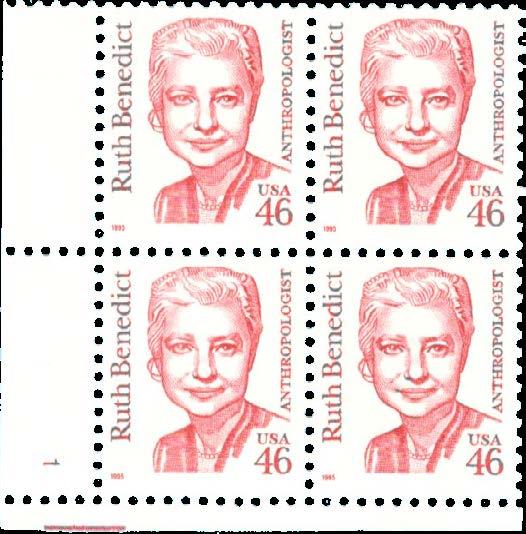
4.
block of the Truman stamps printed from Sleeve 4. This sleeve went to press in September 1993. The printing was on uncoated paper with shiny, diagonally striated gum.
46¢ Ruth Benedict New Issue
The postal rate of 46¢ for a one-ounce letter posted to Canada or Mexico became effective July 9, 1995, so the Bureau produced a 46¢ stamp featuring Ruth Benedict, an American anthropologist who studied cultural structure. The new stamp is shown in Figure 6. Figure 7 shows Benedict stamp marginal markings that marketed the USPS sales catalog.
Sleeve 1 went to the D Press on July 27, 1995, for 311,900 impressions. The stamp was issued on October 20, 1995, in Virginia Beach, Virginia. This stamp was printed on uncoated prephosphored paper.

CC1 Squares
Sometime around 1992, small one-millimeter squares began appearing as marginal markings from the D and F presses, which had offset printing capability. The full purpose and origin of these markings remains unclear to collectors, but the name “CC1 squares” seems to emanate from a company named CC1, Inc., a manufacturer of digital automatic register controls for offset printing presses. Their equipment registers the relative accuracy of the different colors being printed in a multicolored offset printing job.
An example of CC1 square marginal markings on a booklet pane of 29¢ Garden Flowers (Scott 2833a) is shown in Figure 8, issued on April 28, 1994. There is one square
Figure 5. Truman stamp from Sleeve
Figure 6. Ruth Benedict stamp.
Figure 7. Ruth Benedict biographical data.

8.
for each color used during the printing process. Here, we see four offset color squares (cyan, magenta, yellow, and black) and a black intaglio square.
Apparently, the accuracy of the printing relationship of the different colors relative to one another was monitored by high-speed digital cameras. Controls and monitors allowed pressmen to monitor quality control on the fly. CC1, in 2011, claimed waste was reduced, with the use of their system, from 3.0% to 0.8% in most applications. With the Bureau’s installation of a CC1 system, these small color squares began to appear in the margins of their stamps.
Colored CC1 squares also began to appear on mono-colored intaglio printed stamps as well, but why? Color registration relative to other colors wasn’t an issue; nonetheless, these squares began to be added as localized engravings in the margins of existing printing sleeves. Figure 9 shows a CC1 square as added to Sleeve 3 of the Cassatt stamp. On these Great Americans sleeves, the square was added to both the left and right margins.
Some Great Americans stamps that showed CC1 squares were the 4¢ Flanagan (Sleeve 2), 20¢ Truman (Sleeve 4), 52¢ Humphrey (Sleeve 2) and 46¢ Benedict (Sleeve 1). Others exist as well. If you study the Humphrey Sleeve 2 printings, you’ll discover that the CC1 square was relocated from adjacent to the second row of stamps to adjacent to the third row of stamps sometime during its production.
Ink Color Changes

9. CC1 square in the margin of Sleeve 3 of the Cassatt stamp.
According to a spokesperson for the Bureau, it added a new ink supplier in 1995. Collectors of Great Americans have reported color changes for various values, notably to the $1 Hopkins, 3¢ White, and 4¢ Flanagan stamps. But none was as dramatic as the color change in the 10¢ Red Cloud issue. Originally issued in what is cataloged as a “lake” color, the newer stamps are cataloged as “carmine.” Both are shades of red, but the former is a darker shade than the latter. Figure 10 shows a block of the carmine overlaid on a block of the lake shade.
Unlike most color variances in Great Americans issues, Scott elected to list the carmine shade of the 10¢ Red Cloud stamp. It is listed as 2175e. A Linn’s Stamp News article dated September 25, 1995, explained that “[b]ecause the color of the Red Cloud variety
Figure
CC1 squares on the margin of a Garden Flowers booklet.
Figure

Figure 10. Carmine shade overlaid on lake shade.

Figure 11. Red Cloud block with all color omitted.
results from a production change and is not a freak printing, the stamp was given a minor Scott number.” This stamp was printed on uncoated prephosphored paper.
To complete the listings for the 10¢ Red Cloud, a variety known as “all color omitted” appeared on solid prephosphored paper sometime before the switch to untagged prephosphored paper. This variety is listed as Scott 2175f. Figure 11 shows a block of four of the Red Cloud with an American Philatelic Society certificate of authenticity.
Contract Printers Begin Replacing BEP Production
Despite all the efforts the Bureau expended trying to minimize stamp production costs and improve quality, their days as a USPS stamp supplier were numbered as we shall see in the next installment of this series.

If you collect Plate Blocks, Booklets, Coils, or Sheets, the above website, with hundreds of sets at Face Value, will be a great savings to you. Enjoy the hobby.

Armen Hovsepian (APS 150170) P. O. Box 24222 Overland Park, KS 66283 info@USatFACE.com


US Stamp Booklet Cashier Scanner Card
by Bob Trachimowicz USSS # 10462 | m bob.track@charter.net

The recent articles in The United States Specialist reminded me of a “go-with” I obtained in the 1980s from a cashier at the now-shuttered K-Mart in Rosenberg, Texas. It is a thin plastic card, 3⅜" × 2⅛" × 1⁄32" or the size of a standard credit card. It has rounded corners. The front of the card displays the beach scene from the cover of the 1985 $4.40 Sea Shell Booklet, Scott BK 147. See Figure 1. The back has an advertisement for joining the USPS Commemorative Stamp Club. However, unlike Scott BK 147, the back of the card has a USPS copyright notice, dated 1985, and also a UPC bar code. See Figure 2. It is the only example of any cards of this type for any booklets that I am aware of. Images of the front and back of Scott BK 147 are shown in Figure 3 and Figure 4.
Retailers began using bar codes for scanning items in 1974. In the 1980s, scanners were being used by many large retailers. The cashiers at the Rosenberg K-Mart kept this card in the drawer of their registers, along with booklets of Sea Shell stamps. When a customer wanted to buy a booklet of these stamps along with their other purchases, rather than manually ringing up the sale, the cashier would scan the plastic card and then
Booklets and Booklet Panes
Figure 1. Cashier Scanner Card


give the customer the stamp booklet, which was also kept in the register drawer. As I recall, the stamp booklets were sold at face value. This scan card became obsolete with the issuance of the three Jack London booklets in 1986. Questions surround the genesis of this plastic card. Was the card produced by the USPS for any merchants to use for retail stamp booklet sales, or did K-Mart produce this card, with its own bar code, for exclusive use in its stores? Were similar cards produced for other stamp booklets, and if so, which ones? Feedback from readers is greatly appreciated.
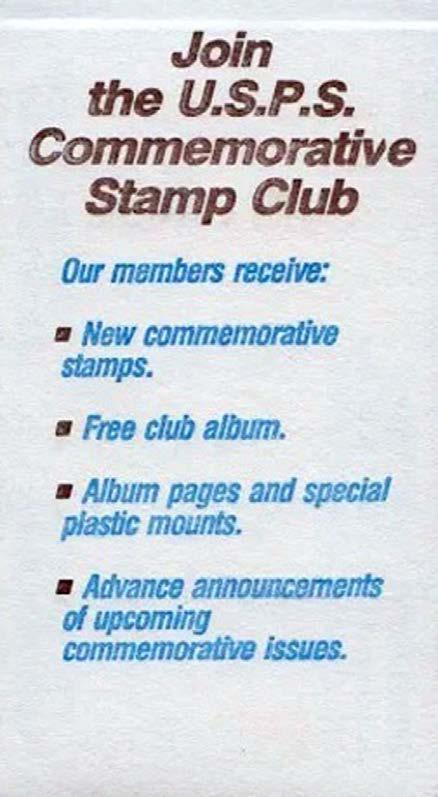
Figure 2. Back of the card in Figure 1.
Figure 3. Front cover of BK 147
Figure 4. Back cover of BK 147. Note the lack of a barcode.
Twelfth International Philatelic Exhibition of the United States proudly presented by

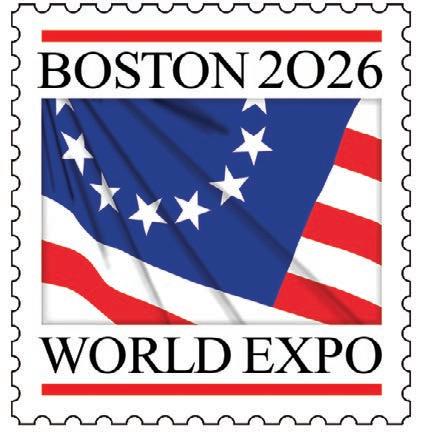





• The Boston Convention and Exhibition Center is located fifteen minutes from Boston Logan International Airport. It is ten minutes from South Station and Amtrak Acela Express to New York City and Washington DC.
• All show hotels will be within walking distance.
• In a 352,000 square foot contiguous exhibition area, BOSTON 2026 WORLD EXPO will be hosting a large dealer and postal administration bourse, as well as a large society presence and hundreds of meetings/events.
• There will be a competitive exhibition of approximately 3,500 frames, plus other special/court of honor exhibits, as well as a large literature competition.

FDR and the 1927 Lindbergh Airmail Stamp, Part I
by Paul M. Holland USSS #16849 | m pholland.thorleaf@gmail.com

After diligent preparation and relatively little fanfare, Charles A. Lindbergh, a 25-yearold former airmail pilot, took off from New York on his historic non-stop flight to Paris early on the morning of May 20, 1927. Lindbergh had helped with the design of the custom-built single-engine Ryan NYP monoplane that he flew, dubbing it the Spirit of St. Louis in recognition of the businessmen who provided financial backing. It was essentially a highly efficient and reliable flying “gas tank” whose forward fuel tank was in front of the pilot, limiting visibility to side windows and an improvised periscope. After flying for 33½ hours, Lindbergh successfully landed in Paris late the following evening, and this became the most famous aviation feat of all time, winning the $25,000 Orteig Prize against much better-financed teams of aviators.
Before his famous transatlantic flight, Lindbergh was the chief airmail pilot for Robertson Aircraft Corporation’s Contract Air Mail Route 2 (CAM-2) that began service from Chicago on April 15, 1926. He is shown loading the first sacks of airmail for the CAM-2 route onto a De Havilland DH-4 biplane in Figure 1.
Lindbergh Airmail Stamp

CAM-2 routing was from Chicago to St. Louis, with stops at Peoria and Springfield, Illinois. Because stamp collectors at the time avidly collected “first flight” covers for each of the different Contract Air Mail Routes, original airmail covers that were flown by Charles Lindbergh as an airmail pilot (before he became famous) are readily available today. In fact, airmail covers flown by Lindbergh both before and after his famous transatlantic flight have become an important collecting theme, and these and related items are often referred to as “Lindberghiana.”1
I have examples of such covers from Lindbergh’s very first official airmail flight franked with 10¢ airplane and map stamps. These bear official post office cachets that show Lindbergh leaving Chicago at 5:30 AM on April 15, 1926. This initial flight carried 87 pounds of mail, with many details on this and other Lindbergh flights provided in the American Air Mail Catalogue. 1 Shown in Figure 2 is my cover to Peoria, Illinois, which was the endpoint for the first official airmail leg ever flown by Lindbergh. The backstamps show a scheduled arrival around 7:00 AM. In Peoria, Lindbergh picked up an additional 23 pounds of mail.
Shown in Figure 3 is my other cover from Lindbergh’s initial southbound flight from Chicago. This continued to St. Louis, with the machine backstamp showing arrival at 10:30 am on April 15, 1926. Interestingly, this cover is addressed to the “Hussman Stamp Company,” and on the back there are later handstamps from a member of the American Air Mail Society (of which I’m also a member) certifying that this cover was “Flown by Lindbergh” and that this is “Lindberghiania.”
Lindbergh later made some return northbound CAM-2 flights on April 15, 1928. I have an example (not shown here) that was flown by Lindbergh from Springfield, Illinois, at 4:30 PM and arrived in Peoria at 5:30 PM.
Figure 1. Loading airmail for CAM-2 route onto a De Havilland DH-4 biplane.

Figure 2. Example of an airmail cover flown by Lindbergh on the first leg of the CAM-2 route.

Before going on to Lindbergh’s famous transatlantic flight the following year, some background information would be in order. Lindbergh was the son of a United States Congressman and was raised in Little Falls, Minnesota, and Washington, DC. He had enrolled as a mechanical engineering student at the University of Wisconsin, but dropped out in 1922, during his sophomore year and moved to Nebraska, where Lindbergh was taught to fly by a veteran airmail pilot. Afterwards, Lindbergh became a barnstormer, a wing walker, and a parachutist. He joined the United States Army Air Service in 1924 and underwent military flight training. Lindbergh graduated first in his class and thus became a second lieutenant in the Air Service Reserve Corps in 1925.
Since the Army did not need additional active-duty pilots at the time, Lindbergh took a job as chief airmail pilot for the Robertson Aircraft Corporation, helping to lay out the newly organized CAM-2 airmail route. Later, while flying this route, Lindbergh twice had very close calls when, due to bad weather, equipment failure, and fuel exhaustion, he was forced to bail out at night. Not seriously injured in either of these mishaps, he became known as “Lucky Lindy,” although it was clear that flying airmail under adverse conditions could be very dangerous. In the meantime, Lindbergh had been closely following progress on the Orteig Prize competition for the first successful nonstop flight between New York and Paris, especially René Fonck’s September 1926 failure. From studying this, he concluded that “a nonstop flight between New York and Paris would

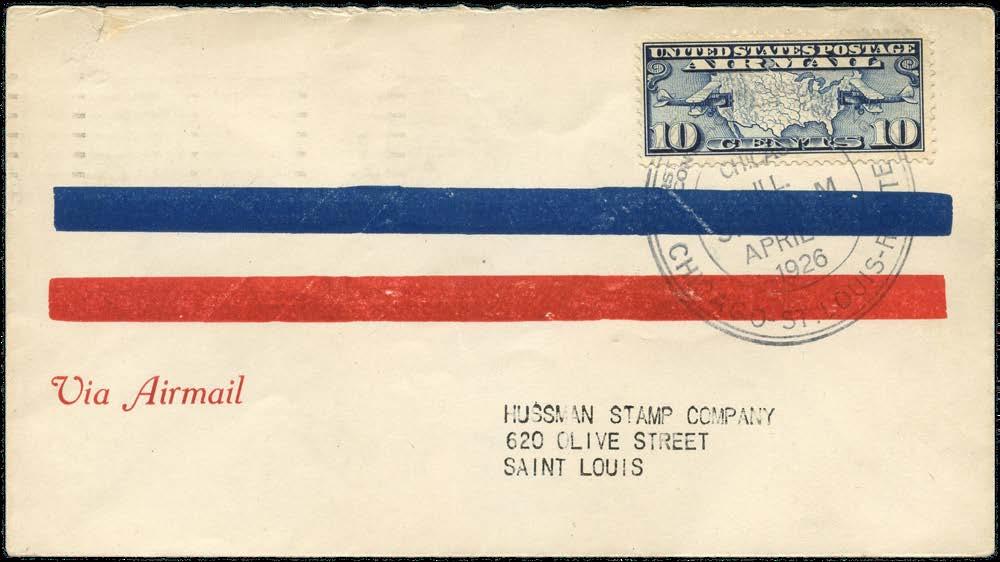
Figure 3. Example of an airmail cover to St. Louis flown by Lindbergh on the first day of the CAM-2 route.

Figure 4. Lindbergh with the Spirit of St. Louis.
be less hazardous than flying mail for a single winter.” At this point, Lindbergh began seriously discussing his ideas for a New York-Paris flight with St. Louis businessmen. Although Lindbergh and the businessmen were able to raise money to purchase a suitable airplane, all of the larger aircraft companies also insisted on selecting a pilot for the attempt. Ultimately, however, the much smaller Ryan Airline Company in San Diego agreed to design and build a single-engine, customized monoplane, working closely with Lindbergh. Named the Spirit of St. Louis in honor of Lindbergh’s backers, this was completed in only two months, and after some initial testing, Lindbergh flew it to New York for his transatlantic attempt. Lindbergh is shown with the Spirit of St. Louis in Figure 4. Lindbergh took off from Roosevelt Field on Long Island, New York, early on the morning of Friday, May 20, 1927. It had been raining and the field was muddy. Carrying a very heavy load of 450 gallons of fuel, the Spirit of St. Louis somehow managed to clear the wires and trees at the end of the runway. Once aloft, Lindbergh headed toward Newfoundland, following a “great circle” route that ultimately passed over Ireland en route to Paris. This route minimized the distance to be flown over open ocean waters, where there were no landmarks, to about 2,000 miles. Lindbergh navigated by “dead reckoning” using an Earth inductor compass, clock, and airspeed indicator. Fortunately, errors due to wind drift largely canceled out, and he was off by only a few miles on reaching the coast of Ireland. After 33½ hours, Lindbergh finally landed in Paris at the Le Bourget Aerodrome late in the evening of Saturday, May 21, 1927. A crowd estimated at 150,000, stormed the field, surrounding the Spirit of St. Louis, as shown in Figure 5. Note the large registration number N-X-211 on the wing that was assigned by the government for experimental aircraft since the Spirit of St. Louis was a nonstandard design.

Figure 5. Arrival in Paris by Lindbergh and the Spirit of St. Louis.
Lindbergh’s successful solo flight across the Atlantic Ocean created a worldwide sensation. On May 25, 1927, Congressman Ernest R. Ackerman, a famed stamp collector2 sent a telegram to Postmaster General (PMG) Harry S. New suggesting that the Post Office Department (POD) “immediately surcharge five hundred million two-cent postage stamps ‘HAIL CHARLES LINDBERGH’ and sell them to the public for three cents each, the premium of one cent on each stamp to be collected for [the] Red Cross.”3 However, it was found that this would require an act of Congress. The POD had also received more letters suggesting a special stamp than at any previous time in its history, and PMG Harry


Figure 6. BEP design for 10¢ Lindbergh stamp.
Figure 7. Large die proof of 10¢ Lindbergh airmail stamp (National Postal Museum).
New decided to issue a special 10¢ airmail stamp honoring the Lindbergh flight in the same format as the airplane and map airmail stamps then in use. In the meantime, the Bureau of Engraving and Printing (BEP), “having felt certain that such a stamp would be issued,” proceeded to prepare a design without waiting for a formal POD request. An artist’s model for this was prepared by A. R. Meissner in conjunction with C. A. Huston, and is shown in Figure 6.3



Figure 8. Plate proof of 10¢ Lindbergh airmail stamp with siderographer and plate finisher initials shown enlarged (National Postal Museum).
Things then proceeded rapidly in an all-out team effort. The model was approved on Friday, June 3, with the engraving of the master die by J. Eissler, E. Hein, E. Hall, and W. Wells completed on Monday, June 6. PMG Harry S. New approved the die proof the following day, as shown in Figure 7. Interestingly, FDR later had the only known small die proof of the Lindbergh stamp and one of the six known large die proofs (BEP control number 333053) in his personal stamp collection.4 The approved die was hardened on June 8, and by the morning of June 9, 1927, six transfer rolls and twelve printing plates had been prepared, with the first printing of Lindbergh airmail stamps later that same afternoon.3
A plate proof of the 10¢ Lindbergh airmail stamp from the collection at the National Postal Museum is shown in Figure 8. Note especially the presence of both siderographer and plate finisher initials in the lower left (LL) and lower right (LR) margins, shown enlarged. Siderographers were the skilled technicians who “laid out” printing plates using a transfer press and roller dies to transfer the stamp design into each position on the plate. Plate finishers then carefully removed any burrs or other flaws that were introduced during plate making. Siderographer initials appear at the LL reading upwards, and the plate finisher’s initials at the LR reading downwards. In the case of plate 18997 (shown), these are J.H.S. for John H. Silbert, Jr., and J.W.G. for James W. Gessford. Because of the frantic rush to production, plates for the 10¢ Lindbergh airmail stamp are especially complex with respect to siderographers and plate finishers, with a total of twelve printing plates produced by seven different siderographers and eleven plate finishers. Details are available in the B.I.A. Plate Number Checklist under Resources.5
Lindbergh and the Spirit of St. Louis returned to the United States aboard the USS Memphis, a US Navy Cruiser, arriving in Washington on June 11, 1927, where he was welcomed by President Calvin Coolidge. The first day of issue for the new 10¢ Lindbergh airmail stamp was set for “Welcoming Home Day” when Lindbergh returned to St. Louis on June 18, 1927. Other first day cities included his birthplace in Detroit, Michigan, and Little Falls, Minnesota, and Washington, DC, where Lindbergh grew up.

Figure 9. First Day Cover for 10¢ Lindbergh airmail stamp.
While I don’t have any favor first day covers on official Post Office Department stationery for the 10¢ Lindbergh airmail stamp, I do have an example from the collection of Edward C. Worden of Millburn, New Jersey, a prominent first day cover collector. Shown in Figure 9, this is on Worden’s personal airmail stationery, postmarked in St. Louis, and is self-addressed c/o the Postmaster of Detroit, Michigan. Note that this bears the special ‘Lindbergh Celebration’ cachet that was applied in St. Louis.
Following this first day celebration in St. Louis, Lindbergh was promoted to colonel in the Army Air Corps, among many other honors and recognition. In Part II of this article, I plan to show various usages of the Lindbergh airmail stamp, additional covers flown by Lindbergh, some examples of Lindbergh covers sent to FDR , and briefly mention Lindbergh’s impact on worldwide philately.
References
1. American Air Mail Catalogue, 5th edition, Volume Three, American Air Mail Society, Cinnaminson, NJ, 1978, pages 1409–1478.
2. Stanley M. Bierman, The World’s Greatest Stamp Collectors, Linn’s Stamp News, 1990, pages 213–220.
3. Max G. Johl, The United States Postage Stamps of the Twentieth Century: Volume III 1922–1935 Parcel Post, Air Mails, H. L. Lindquist: New York, 1935, pages 204–210.
4. The President Franklin D. Roosevelt Collection: H. R. Harmer, Inc., New York, Part One: February 1946, lot 138 and lot 74.
5. B. I. A. Plate Number Checklist: Plates 1–20,000, United States Stamp Society, Revised 1990.
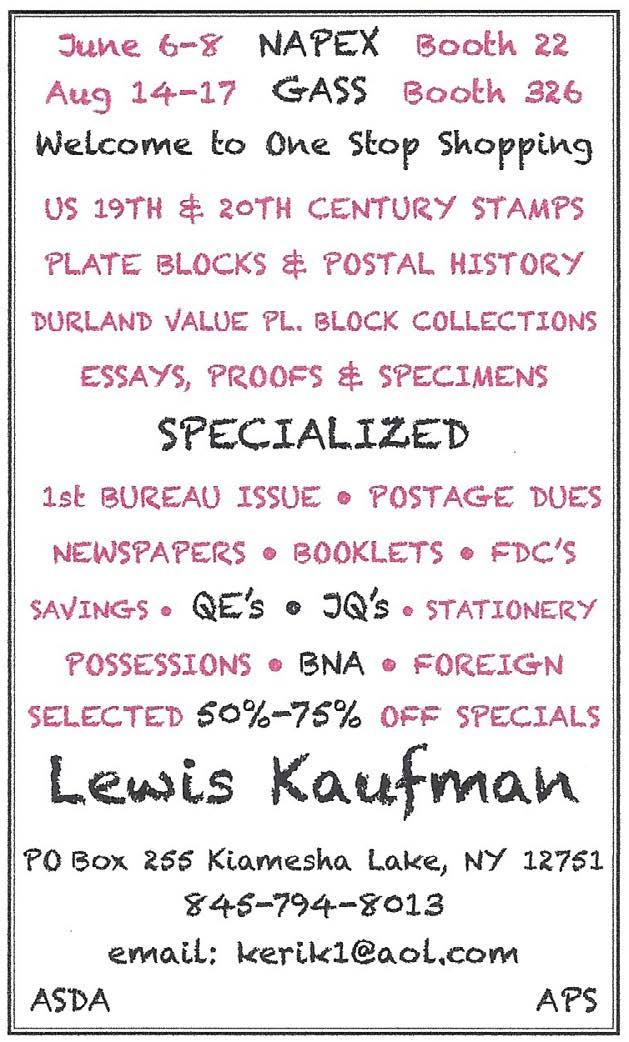
Quality
United States Stamps (1847-1945)
Singles (mint and used)
Plate Blocks
Booklet Panes plus Complete Booklets
Price lists-$2.00 each category
Price lists free on web: www.mountainsidestampsandcoins.com

We also buy quality U.S. and foreign stamps
Mountainside Stamps, Coins and Currency
P. O. Box 1116
Mountainside, NJ 07092
Tel: 908-232-0539 or 908-419-9751
E-mail: tjacks@verizon.net
Tom Jacks, owner
Member APS, ASDA, USSS

From the Washington-Franklin Head Committee
Why the Lilac Shade of Scott 376 Is Definitely Worth Looking For
by Kevin G. Lowther USSS # 14367| m klowther5@gmail.com
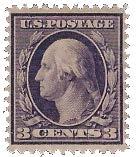


How scarce is the lilac shade of Scott 376?
The 3¢ stamp on single-line watermarked paper was issued in January 1911 in violet. Scott lists it at $40 in mint, never-hinged condition. The comparable lilac variety lists at $50, just 25 percent more. It can’t be very scarce at that differential, especially if Scott does not endow it with a separate number.
There are two examples in my collection. The mint single in the middle of Figure 1 once resided in Larry Weiss’s important holding of Washington-Franklins. I paid $85 for it, including premium, in a 1997 Drews sale. The cover shown in Figure 2, mailed to Paris in 1912, has the 3¢ lilac in virtually the same shade. I wonder how many other Washington-Franklin specialists have a copy. Not many, I suspect.
Figure 1. Comparison of violet shade of Scott 376 (left), the lilac shade (middle), and Scott 341 (right).

Figure 2. Lilac shade of Scott 376 on a September 23, 1912 cover to Paris.
When the shade was first reported in the philatelic media in March 1912, it was described as lavender by Philadelphia dealer Percy McGraw Mann.1 By the 1930s, Max G. Johl was calling it lilac—and scarce.
Lewis A. Miers, a member of the then-Bureau Issues Association, was less enthused. “The stamp is said to be an error of color as the shade closely resembles that of the 50¢ issue of 1908,” he wrote in the January 1961 Specialist. “These show up in dealers’ stocks occasionally and [are] not too expensive.” But then he added, “They are worth looking for.”2
Figure 1 shows, from left to right, the typical violet shade of Scott 376, the lilac version, and the normal violet 50¢ stamp (Scott 341), which Miers claimed nearly matched the lilac shade. The examples in Figure 1 do not support Miers. The only other shade listed for Scott 341 is dull violet. If anything, it is the regular violet Scott 376 which mimics the 50¢ shade, not the lilac shade, which stands out against both.
Johl was right to judge the lilac shade of Scott 376 as scarce. Miers also was right to suggest the shade is worth looking for.
Good luck.
References
1. “3¢ U. S. 1908–1910 Lavender,” Philadelphia Stamp News, March 2, 1912.
2. Lewis A. Miers, “Odd Shades Among the Bureau Issues,” The Bureau Specialist, January 1961, p. 10.
Precancel Stamp Society
Interested in Learning More about Precancels? Request a copy of “Th e ABCs of Precancel Collecting” and also receive a sample copy of the PSS Forum, the Precancel Stamp Society’s monthly journal. Contact: Frank Bird III, 1095 Pinellas Point Dr South, Apt 352, St. Petersburg, FL 33705-6377. Email: promo@precancels.com.


Woodrow Wilson in Liberty Series
by Rodney A. Juell USSS #13852 | P.O. Box 3508, Joliet, IL 60434
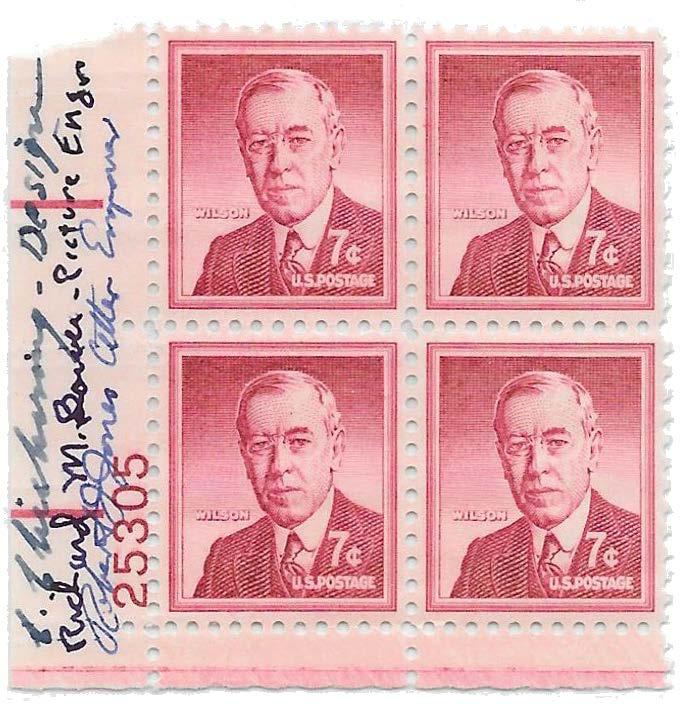
This month’s photo shows Edith Wilson, widow of President Woodrow Wilson, on January 10, 1956, receiving a presentation pane of the new 7¢ Woodrow Wilson stamp (Scott 1040) in the Liberty Series. Presenting the pane is the director of the Post Office’s Division of Philately, Robert E. Fellers. Mrs. Wilson has been called, only slightly tongue-in-cheek, the first woman president of the United States, since she virtually ran the office after her husband was incapacitated by a stroke. Shown is a plate block of the stamp signed by legendary BEP designer Charles Chickering; Richard Bower who engraved the portrait; and Robert Jones who engraved the lettering.
Vintage Photo of the Month



Discovery: New Precancel City for Scott 1056
by Roland Austin USSS # 13032 | m raustin13@aol.com

It is exciting to discover an unknown variety of a stamp, especially if it has been long thought that there were no other varieties for that particular stamp to be found. That is exactly what USSS member Herman Axelrod did!
As reported in USSS Research Paper #12 by Steven Unkrich, there were 41 known Bureau-precanceled cities on the small-hole variety of the 2½¢ Bunker Hill coil stamp: Birmingham Alabama, Los Angeles California, Pasadena California, San Francisco California, Boulder Colorado, Washington DC, Jacksonville Florida, Atlanta Georgia, Des Moines Iowa, Chicago Illinois, Brownstown Indiana, Louisville Kentucky, New Orleans Louisiana, Boston Massachusetts, Baltimore Maryland, Detroit Michigan, Grand Rapids Michigan, Minneapolis Minnesota, Saint Paul Minnesota, Kansas City Missouri, Saint Louis Missouri, Jackson Mississippi, Omaha Nebraska, Brooklyn New York, Buffalo New York, New York New York, Cincinnati Ohio, Cleveland Ohio, Dayton Ohio, Portland Oregon, Harrisburg Pennsylvania, Pittsburgh Pennsylvania, Rock Hill South Carolina, Memphis Tennessee, Austin Texas, Dallas Texas, Houston Texas, San Antonio Texas, Seattle Washington, Spokane Washington, and Milwaukee Wisconsin. Specialists believed this list was complete.
Thanks to Mr. Axelrod’s discovery, there are now 42 Bureau-precanceled cities on the small-hole variety Scott 1056. Add Berkeley, California.
From the 1954 Liberty Series Committee
Figure 1. American Philatelic Expert Committee Report certifying Scott 1056 line pair precanceled “BERKELEY, CALIF.” with small holes as genuine.

The new discovery is a line pair pictured in Figure 1 on the American Philatelic Society Expert Committee certificate number 245846, dated April 7, 2023, with the opinion that it is: “United States, Scott 1056, small holes, unused, full original gum, never hinged. Genuine.”
According to the Precancel Stamp Society style chart, this is Bureau precancel style 71.
As stated in the Scott Specialized Catalogue of United States Stamps & Covers, the small-hole Bunker Hill coil stamps are known only in Bureau-precanceled format, accounting for their rarity. Postal regulations when these stamps were issued allowed only permit holders access to mint precanceled stamps for their use. Resale was prohibited, but collectors acquired some mint pairs; many had the gum soaked off, rendering them “used” for legal collecting, but a few were retained with original gum and made their way onto the market.
The small amount of mint, full original gum line pairs existing are so rare that the Scott Catalogue lists them with a value of $3,000.00.
Thanks to Steven Unkrich for supplying the current list of cities.
Addendum: Mr. Axelrod later informed me that a friend of his found an additional precancel city for Scott 1056 with small holes—Miami Florida—and has obtained a certificate from the Philatelic Foundation. Thus, the city count stands at 43! Who will discover number 44?

The
Coming
and
Going
of China Clay in BEP Printing Paper: Kaolin Content in the 2¢ Stamps of the First, Second, Third, and Fourth Bureau Issues
by Harry G. Brittain, P h D USSS # 16446 | m hgbrittain@gmail.com

Figure 1. XRD patterns of cellulose and of cellulose that had been spiked with approximately 10% of kaolin (i.e., white or “China clay”).
In a previous paper,1 I reported the qualitative results of studies where I used X-ray diffraction (XRD), a forensic analytical technique, to study the mineral content of paper used by the United States Bureau of Engraving and Printing (BEP) between 1894 and 1913. The forensic evidence demonstrated that the paper on which all stamps printed between 1894 and 1908 contained kaolin (also known as white clay or China clay) as a
Forensic Analysis of Stamp Paper
filler. This work also demonstrated that all stamps printed between 1908 and 1913 were printed on paper that did not contain kaolin.
In a subsequent paper 2, I developed a mathematical relationship that correlated the intensity of a particular kaolin XRD peak with the percentage of kaolin present in the analyzed stamp. This development allowed me to use the observed XRD intensities to calculate an accurate measurement of the amount of kaolin present in any given sample of stamp paper. This particular study involved the XRD characterization of 1,430 plate-numbered stamps printed between 1904 and 1908. By correlating the plate numbers of the analyzed stamps with the historical information contained in the B.I.A. Plate Number Checklist,3 I developed a chronology of kaolin content in the printing papers used by the BEP during this time frame.
With the computational method in hand, I then conducted a retrospective analysis of the XRD results acquired during the first two studies. In this study 4, I used the quantitative XRD method to develop a complete history of the kaolin content in the paper used by the BEP to print stamps between 1894 and 1904. One of the conclusions I reached was a confirmation that all of the stamps of the Third Bureau Issues were printed on paper consisting of cellulose only and did not contain kaolin as a filler compound. It is to be noted that this finding is consistent with other reports published in The Specialist.5,6
My XRD studies into the paper on which BEP stamps were printed have continued, still using the protocol of correlating forensic analytical results with approximate printing dates as disclosed in the B.I.A. Plate Number Checklist. 3 Through analyzing the entirety of plate-numbered 2¢ regular issue stamps in my collection, I have deduced a historical timeline of kaolin content in the paper used to print these regular issue stamps of the First, Second, Third, and Fourth Bureau issues.
The database of XRD patterns that I have developed consists of 434 uniquely numbered 2¢ stamps from the First Bureau Issues (Scott numbers 248, 250, 265, 267, and 279B), 1,040 2¢ stamps from the Second Bureau Issues (Scott 301 and Scott 319), 504 2¢ stamps from the Third Bureau Issues (Scott numbers 332, 375, 406, 425, 463, 499, and 528), and 839 2¢ stamps from the Fourth Bureau Issues (Scott numbers 554, 583, 634). Thus, the results and trends described in the following sections represent the acquisition and analysis of the XRD patterns of over 2,800 stamps bearing unique plate numbers. Since the publication of the previous papers in this series, I have acquired new and more accurate XRD instrumentation. In the interests of publishing results of the highest quality, I have re-acquired the XRD diffraction patterns of my entire series of 2¢ stamps. Only these newest results and their interpretation will be presented in the current paper.
Methodology Summary
It is well known to forensic analytical scientists that the XRD pattern of kaolin clay consists of two major peaks, observed at angles of 12.3° 2θ, and 24.9° 2θ. 7 As shown in Figure 1, the XRD pattern of a stamp printed on kaolin-containing paper will consist largely of the sharp kaolin peaks superimposed onto the broad XRD bands of the cellulose component of the paper (i.e., one split feature at approximately 15–16° 2θ, and a relatively strong peak at approximately 22.5° 2θ). Of the two peaks, the peak at 12.3° 2θ is more useful for quantitative analytical purposes as it is generally not overlapped by other mineral components. The method described in the previous paper 2, and refined
for the current work, consists of measurement8 of the intensity of the kaolin peak at 12.3° 2θ, followed by the calculation of kaolin content using a simple linear relationship. While graphs of kaolin content as a function of plate number are highly informative, plots of kaolin content as a function of approximate stamp date would greatly facilitate an understanding of the historical sequencing in the XRD results. The B.I.A. Plate Number Checklist 3 provides the “hardened” or “first to press” dates that are tabulated by plate and Scott number and represent a reasonable estimate of when a particular stamp was printed. However, since the dates are present in the ordinary format of month/day/year, I needed to develop a computational method to translate the ordinary date format into a decimal-based format suitable for plotting. My method makes use of the date calculation function in Microsoft Excel. This command is in the form of DAYS360(A,B), where A is a reference year date and B is the actual stamp date derived from the checklist.
To illustrate the computational method, consider Scott 301, plate 1515. The B.I.A. Checklist lists a “first to press date” of December 8, 1902 for this stamp. Inputting A=1/1/1902 and B=12/8/1902, one finds that plate 1515 first went to press on the 337th day of the year. To obtain a stamp date suitable for plotting, one simply divides 337 by 365 (the number of days in a year) to obtain the fractional date of this stamp (i.e., 0.9233). Numerically adding the fractional date to the year of issue yields the date of the stamp in decimal form (1902.9233 in the current example). This calculation was performed for all 2557 plate-numbered stamps of the present study, enabling graphs to be developed of kaolin content as a function of stamp printing dates.
Kaolin Clay Content in Stamps of the First Bureau Issues
In 1894, the BEP assumed responsibility for the printing of postage stamps and issued a number of definitive issues. The initially released pink 2¢ stamp (Scott 248) featured the image of George Washington on the vignette. The color of the 2¢ stamp was quickly changed to carmine (Scott 250), and carmine remained the color of choice for the rest of the series. These stamps were printed on various paper types and also featured minor changes in the details of the frame around the vignette. The differences between Scott 248 and 250 and the later members of the First Bureau Issue distinguish them from the later Scott 265, 267, and 279B.
In the present work, the XRD patterns of 6 Scott 248 plate-numbered strips of three, 6 Scott 250 plate-numbered strips of three, 6 Scott 265 plate-numbered strips of three, 22 Scott 267 plate-numbered strips of three and 168 plate-numbered singles, and 38 Scott 279B plate-numbered strips of three and 188 plate-numbered singles were acquired. Thus, a total of 434 plate-numbered stamps of the First BEP series were analyzed. Representative examples of each stamp type are found in Figure 2.
Figure 3 summarizes the kaolin content detected for the analyzed stamps of the First Bureau Issues, showing the results both as a function of plate number as well as approximate printing dates. The initial Scott 248 and Scott 250 stamps were printed on paper that contained 11–16% kaolin. The different paper used to print Scott 265 contains a significantly larger amount of kaolin, ranging from 20% to 25%. While significant variations were found for the amount of kaolin in the printing paper of Scott 267 and Scott 279B, the range of kaolin was fairly consistent in the 10% to 30% range.
The historical timeline indicated one particular region of interest for the Scott 267 stamps where, for some reason, the BEP used paper with a very low amount of kaolin. The stamps beginning with plate number 426 (plate hardened, May 15, 1897) and 466 (plate hardened, June 11, 1897) were printed on paper that contained an average of only 8% kaolin, which is significantly less than the normal range of kaolin contents measured for Scott 267 Stamps.
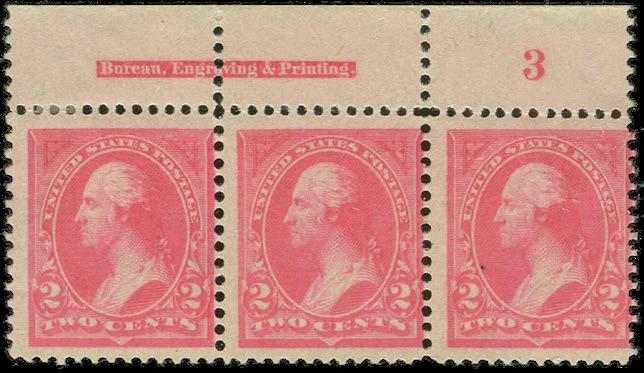
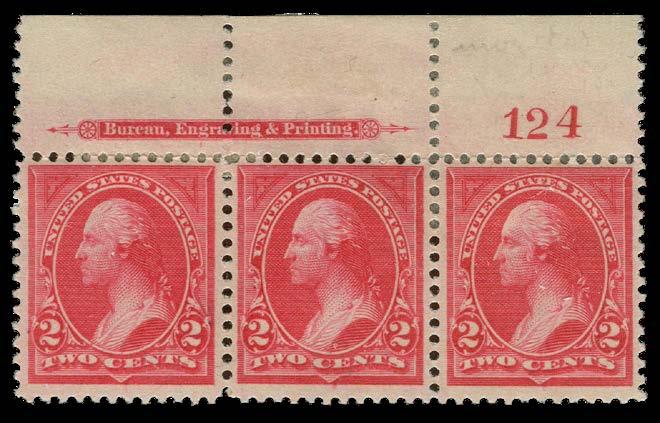



Figure 2. Representative examples of (a) Scott 248, (b) Scott 250, (c) Scott 265, (d) Scott 267, and (e) Scott 279B. These are the most common 2¢ stamps of the First Bureau Issue.
(c) Scott 265, plate 124, first to press January 11, 1895.3
(d) Scott 267, plate 210, first to press October 18, 1895.3
(e) Scott 279B, plate 1309, first to press January 24, 1902.3
(a) Scott 248, plate 3, first to press July 2, 1894.3 (b) Scott 250, plate 8, first to press July 7, 1894.3


Figure 3. Summary of the kaolin content measured for the 2¢ First Bureau Series stamps, Scott 248 (black dots), 250 (red dots), 265 (blue dots), 267 (purple dots), and 279B (green dots). The uppermost plot displays the kaolin results as a function of plate number, while the lower plot shows the same data but plotted according to the date of plate hardening.
Kaolin Clay Content in Stamps of the Second Bureau Issues
Scott 301 is the first-issued 2¢ stamp of the Second Bureau Issues. This study encompassed the analysis of 46 plate-numbered examples of this stamp. Scott 301 was subsequently replaced with a completely new design, Scott 319. Scott 319 is subdivided into categories based on the dies used to create printing plates. A total of 844
plate-numbered Die I and 150 Die II stamps were analyzed, for a total of 994 Scott 319 stamps. Representative examples of each stamp type are found in Figure 4.

(a) Scott 301, plate number 1518, first to press December 13, 1902.3
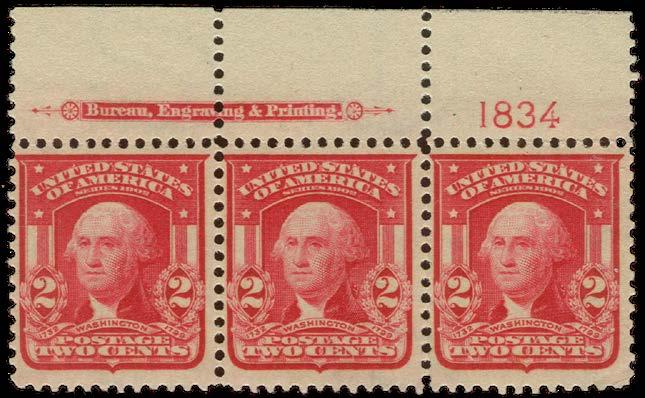
(b) Scott 319 (Die I), plate number 1834 first to press October 27, 1903.3

(c) Scott 319 (Die II), plate number 4360, first to press May 1, 1908.3
Figure 4. Representative examples of 2¢ Second Bureau Series stamps, (a) Scott 301, (b) Scott 319 Die-I, and (c) Scott 319 Die II.
Figure 5 summarizes the kaolin contents detected for all the analyzed stamps of the Second Bureau Issues. Careful examination of the two halves of the figure indicates that based on the kaolin content values, the printing history of these 2¢ stamps consisted of one interval associated with Scott 301 and eight distinct time intervals associated with Scott 319. The trends in each of these intervals will be discussed in turn.
Interval 1. All of the stamps in this interval were Scott 301. The series of 46 unique plate-numbered stamps of my collection began with plate 1515 (first to press December 8, 1902), and ended with plate 1759 (first to press October 1, 1903). Analysis of the data revealed a substantial spread in the results, with the kaolin content values ranging between 9% and 16%. Within this interval, the average kaolin content in the analyzed Scott 301 stamps was 13.5%.
Interval 2. Since the initial 2¢ stamps of the Second Bureau Issue were not well received, the Bureau began late in 1903 to issue stamps having a completely new design. These stamps are Scott 319, with the plates having been prepared using the first die, Die I. All of the stamps within the second interval were printed on paper that contained kaolin as the filler. The analyzed stamps in my collection ran from plate 1805 (first to press October 13, 1903) through plate 2365 (first to press on December 23, 1904), and


Figure 5. Summary of the kaolin content measured for the 2¢ Second Bureau Issue stamps, Scott numbers 301 (green dots), 319, Die I (red dots), and 319, Die II (blue dots). The uppermost plot displays the kaolin results as a function of plate number, while the lower plot shows the same data but plotted according to the date when the plate first went to the press.
a total of 198 plate-numbered stamps were studied. The actual kaolin content values in these stamps were quite variable, ranging from a low value of 3% to a maximum value of 19%, with an average kaolin content of 10.1%.
Interval 3. Interestingly, beginning with plate 2366 (First to press December 23, 1904) and ending with plate 2838 (First to press January 2, 1906), a total of 236 analyzed stamps were found to contain no kaolin at all. Obviously, the BEP sourced paper with a totally different composition during this interval, though it is unclear whether they did so accidentally or purposefully.
Interval 4. The stamps of this interval were relatively few in number, but represent a brief time period when the BEP used kaolin-containing printing paper once more. Here, only a total of 10 plate numbered stamps constitute Interval 4, beginning with plate 2840 (First to press December 22, 1905) and ending with plate 2857 (First to press January 8, 1906). Here, a much tighter range of kaolin content values was observed, ranging from a low value of 5% to a maximum of 8%. Within this interval, the average kaolin content was 6.0%
Interval 5. The next series of Scott 319 stamps were found to contain no kaolin at all. Here, a total of 92 plate-numbered stamps were analyzed, with plate numbers ranging from 2858 (first to press January 31, 1906) and concluding with plate 3172 (first to press October 8, 1906).
Interval 6. The 170 stamps of this interval began with plate 3174 (first to press October 8, 1906) and ended with plate 3717 (first to press August 7, 1907). What makes the stamps of Interval-6 rather interesting is the observation that 97 plate numbers were printed on kaolin-containing paper, while 73 plate numbers were printed using paper consisting only of cellulose. As evident in Figure 3, no trend in kaolin content values could be deduced within this interval, and one might conclude that the BEP obtained paper from a variety of vendors without paying too much attention to the quality of that paper.
Interval 7. The chaos of the preceding interval disappeared with the advent of a new interval consisting of 138 plate-numbered stamps beginning with plate 3724 (first to press August 14, 1907) and ending with plate 4286 (first to press April 8, 1908). All of these stamps represent the final stamps whose plates were made with Die I, and were printed on kaolin-free paper.
Interval 8. The stamps of the penultimate Scott 319 interval were printed from plates prepared using a re-engraved die, known as Die II. The stamps of this interval began with plate number 4292 (first to press April 8, 1908) and ended with plate number 4361 (first to press May 1, 1908).
What makes the stamps of this interval so interesting is that the initially produced Die II stamps were all printed on kaolin-containing paper. The spread in kaolin content was fairly modest, ranging from 6% to 11% (average value of 8.1%). Perhaps the BEP wanted to use a higher-quality printing paper for the initial series of Die II stamps.
Interval 9. However, beginning with plate 4365 (first to press May 1, 1908) and ending with the last plate in my collection (number 4776, first to press September 16, 1908), the remainder of the Scott 319 Die II stamps were printed on kaolin-free paper.
Kaolin Clay Content in Stamps of the Third Bureau Issues
The first two 2¢ sheeete stamps of the Third Bureau Issues also featured the image of George Washington, Scott numbers 332 and 375. Because the denomination was written in words rather than numerals, these stamps are commonly known as the “Two Cents” type. Representative examples of Scott 332 and 375 stamps are shown in Figure 6.

(a) Scott 332, plate 5072 first to press May 12, 1909.3

(b) Scott 375, plate 5558, first to press November 16, 1910.3
Figure 6. Representative Examples of the “Two Cents” stamp types of the Third Bureau Issues, namely (a) Scott 332 and (b) Scott 375..
Upon completion of XRD studies on 111 “Two Cents” stamps, it was found that none had been printed on kaolin-containing paper. The stamps in my collection, which were studied during this portion of the work, ran from plate number 4481 (first to press June 2, 1908) through plate 5690 (first to press November 6, 1911).
The remainder of the 2¢ stamps of the Third Bureau Issues encompass examples of Scott 406, 425, 463, 499, and 528. These are known as the “2 Cents 2” type because the denomination is written in Arabic numerals. While most of these stamps were printed
Figure 7. Representative Examples of the “2 Cents 2” Type of the Third Bureau Series, namely (a) Scott 406, (b) Scott 425, (c) Scott 463, (d) Scott 499 prior to the issue of the offset stamps, (e) Scott 528 offset, and (f) Scott 499 subsequent to the issue of the offset stamps.

(a) Scott 406, plate 5960, first to press May 9, 1912.3

(d) Scott 499, plate 9101, first to press October 25, 1918.3

(b) Scott 425, plate 7339 first to press May 3, 1915.3

(e) Scott 528, plate 11594, first to press July 8, 1920.3
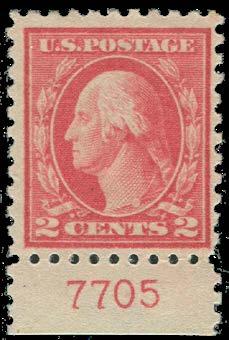
(c) Scott 463, plate 7705, first to press May 22, 1916.3

(f) Scott 499, plate 13727, first to press May 18, 1922.3
using the usual engraving method, Scott 528 was produced using a lithographic process. Representative examples of these “2 Cents 2” types are found in Figure 7.
As had been noted in the XRD analysis of the “Two Cents” stamps, the analysis of an ensemble of 393 “2 Cents 2” stamps revealed that none of these stamps had been printed on kaolin-containing paper. The stamps studied in this portion of the work spanned plate 5769 (Scott 406, first to press on December 6, 1911) and ended with plate 14019 (Scott 499, first to press on November 20, 1922).
The forensic results obtained via the XRD analysis of 504 Third Bureau Issue stamps demonstrate that none of the stamps from this series were printed on kaolin-containing paper. Rather, all were printed on paper consisting entirely of cellulose. I elected not to plot the kaolin contents for the stamps of the Third Bureau series since the plot would have been an uninteresting sequence of zeroes. These findings are in accord with previously reported results.5, 6
Kaolin Clay Content in Stamps of the Fourth Bureau Issues
The 2¢ stamps of the Fourth Bureau Issue continued the practice of featuring George Washington in the vignette. This series began with stamps printed using the traditional flat plate method (Scott 554), and continued with stamps using the newer rotary press (Scott 583 and 634). The studies conducted on the Fourth Bureau Issue stamps in my col-

(a) Scott 554, plate number 14423, first to press March 31, 1923.3

(b) Scott 583, plate number 17972, first to press March 12, 1926.3

(c) Scott 634, plate number 19896, first to press January 20, 1930.3
Figure 8. Representative examples of 2¢ Fourth Bureau Issue stamps. Shown are (a) the flatplate printed Scott 554, and the rotary press printed (b) Scott 583 and (c) 634.
lection consisted of XRD analysis of 839 uniquely plate-numbered stamps. Representative examples of these 2¢ Fourth Bureau Issue stamps are found in Figure 8.
The initial Fourth Bureau Issue stamps were printed using the flat press method that the BEP had used since it took over the business of printing postage stamps. For the present, the XRD patterns of 551 Scott 554 stamps were acquired, beginning with plate 14074 (first to press, October 26, 1922) and ending with plate 17809 (first to press, December 3, 1925). As was the case for the stamps of the Third Bureau Issue, no kaolin was detected in the paper associated with any of the analyzed Scott 554 stamps.
Similarly, the printing papers associated with the 46 Scott 583 stamps in my collection were also found not to contain any measurable kaolin content. My Scott 583 stamps began with plate 15820 (first to press December 2, 1924) and ended with plate 18947 (first to press, May 24, 1927).
XRD analysis of the 242 Scott 634 stamps in my collection yielded exceedingly interesting results that divided these stamps of the Fourth BEP Bureau Issue into two categories.
Category 1, no kaolin in the printing paper: For the 106 stamps in my collection having plate numbers 18764 (first to press, November 20, 1926) through 19380 (first to press, January 24, 1929), none of the printing papers were found to contain kaolin.
Category 2, kaolin in the printing paper: Beginning with plate number 19383 (first to press, February 5, 1929), the remaining 136 Scott 634 stamps in my collection were printed on paper that contained measurable amounts of kaolin. The use of kaolin-containing paper was continued through the last Scott 634 stamp in my collection, plate number 21689 (first to press, December 29, 1937).
Although not part of the Fourth Bureau Issue, the 2¢ stamps of the 1932 Washington Bicentennial Issue were printed contemporaneously with the latter portion of the Scott 634 printings. An example of Scott 707 is provided in Figure 9. These stamps were printed beginning with plate number 20565 (first to press August 14, 1931), and the series concluded with plate 20806 (first to press March 22, 1932). Since XRD analysis of the 47 plate-numbered Scott 707 stamps in my collection revealed that every example was printed on kaolin-containing paper, the results collected from these stamps has been included in the Fourth Bureau Issue database.

Figure 9. Representative example of a 2¢ stamp from the 1932 Washington Bicentennial series, Scott 707, a rotary press stamp. Plate number 20631 was first to press October 15, 1931.3
Figure 10 contains a full summary of the kaolin contents (or lack thereof) measured for the entire series of analyzed Fourth BEP Series stamps of my collection, including the Scott 707 stamps. Although the calculated amounts of kaolin in the latter stamps of the Fourth Bureau series exhibited the usual degree of variability, the kaolin contents were found to fall consistently in the 5% to 20% range. It may be noted how the kaolin content in the printing paper of the Scott 707 stamps fits within the general trend of the Scott 634 stamps, demonstrating that the use of kaolin-containing paper was not restricted to the stamps of the Fourth Bureau Issue.
Discussion
Figure 11 summarizes the kaolin contents that were measured for all 2¢ plate-numbered stamps of the First, Second, Third, and Fourth Bureau Issues in my collection. This survey of over 2,700 stamps begins with the first 2¢ stamps issued by the BEP in the Fall of 1894 and concludes with the 2¢ stamps issued near the end of 1937. The plot also contains the XRD results obtained on the Scott 707 stamps, treated in the figure as Fourth Bureau Issue stamps.
One feature that stands out in the results shown in Figure 10 is the variability in kaolin values when that compound was used as a filler agent in the printing paper. Given that millions of stamps were being printed and that the BEP never kept large stocks of paper on hand, it would not be surprising that the BEP would have been constantly obtaining new supplies of paper. Without tight specifications of kaolin content (which would have been estimated by the mineral content in the paper), it is no wonder that


Figure 10. Summary of the kaolin content measured for the 2¢ Fourth Bureau Series stamps, Scott numbers 554 (red dots), 583 (blue dots), and 634 (green dots). Also shown are the kaolin contents measured for the included Scott 707 stamps (purple dots). The uppermost plot displays the kaolin results as a function of plate number, while the lower plot shows the same data but plotted according to the date when the plate first went to the press.
the kaolin results associated with a given BEP series presented in this paper exhibit significant quantitative variations.
But when viewed in a qualitative sense (i.e., kaolin-containing or kaolin-free), the results shown in Figure 10 reveal that history can be roughly divided into three eras based on the qualitative nature of the printing paper used in each period.


Figure 11. Comprehensive summary of the kaolin content calculated for all 2¢ plate-numbered stamps of the First (red dots), Second (purple dots), Third (black dots), and Fourth Bureau Issues (green dots). The results obtained on Scott 707 stamps have been included in the Fourth Bureau Issue category.
The first era began near the end of 1894 when the BEP issued its first stamps, all of which were printed on kaolin-containing paper. The amount of kaolin in the paper decreased significantly when BEP Second Series began to printed, but nevertheless, all stamps printed up to approximately 1904 were printed exclusively on kaolin-containing paper. The interval spanning the middle of 1904 and the beginning of 1908 represents a time when BEP printing made use of both kaolin-containing and kaolin-free paper, but after 1908, the use of kaolin-containing paper ended.
The second era ran from roughly the beginning of 1908 until the beginning of 1929 and represents the time when all of the 2¢ stamps were printed exclusively on kaolinfree paper. This time period spans the entire printing history of stamps from the Third Bureau Issues (aka, the Washington-Franklin series), and the results presented in this paper weigh strongly against the proposal that any of these stamps had been printed on “China Clay” paper. This finding, of course, is in accord with the work of Liston,5 who concluded, based on a limited XRD study, that no stamps of the Third Bureau Issue were on paper containing “China Clay.”
The third era begins in early 1929 and corresponds to when the BEP returned to printing stamps on kaolin-containing paper. This category of paper was used continuously until the end of 1937, when the scope of the present study ends. But, one may ask, “Is that the end of the story, or did the use of kaolin-containing paper continue?” This question will be answered in a follow-up paper that will detail the results of XRD analyses conducted on commemorative, airmail, and regular issue stamps having plate numbers between 19000 and 24911. Without giving away too much, all I will say at this time that the use of kaolin-containing paper became a regular feature of stamps printed by the Bureau between roughly 1927 and 1954. Stay tuned for the next part of the historical sequence!
References
1. Harry G. Brittain, “X-Ray Diffraction Study of the Paper Used by the Bureau of Engraving and Printing to Produce 1¢ and 2¢ Stamps Between 1894 and 1913”, The United States Specialist, 87(8), 2016, pp. 345–361.
2. Harry G. Brittain, “X-Ray Diffraction Study of the Kaolin Content in Paper Used to Produce Stamps During 1903–1908”, The United States Specialist, 89(9), 2018, pp. 403–416.
3. W. Wallace Cleland, B.I.A. Plate Number Checklist, Plates 1–20,000, Belleville, Illinois: Bureau Issues Association, 1990.
4. Harry G. Brittain, “Kaolin Content in Paper Used by the Bureau of Engraving and Printing to Produce 1¢ and 2¢ Stamps Between 1894 and 1908”, The United States Specialist, 90(2), 2019, pp. 61–71.
5. Edward M. Liston, “The “China Clay” Variety of the 1908–1910 Washington-Franklin Issue”, The United States Specialist, Vol. 77. 2006. Part 1: 77(1), pp. 27–34; Part 2: 77(2), pp. 61–69.
6. Larry Weiss, “The “China Clay” Stamps: A Commentary”, The United States Specialist, 77(2), 2006, p. 70.
7. Duane M. Moore and Robert C. Reynolds, Jr., X-Ray Diffraction and the Identification of Clay Minerals, 2nd edition, Oxford: Oxford University Press, 1997, pp. 233–239.
8. The XRD diffraction patterns reported in this work were obtained using a Rigaku MiniFlex-II powder diffraction system, equipped with a vertical goniometer operating in the 2θ/θ mode, and a copper X-ray source (using the Kα emission of 1.54184 Å). Each stamp was fixed in a horizontal sample holder, and was scanned over the range of 3.0 to 41.0° 2θ, at a scan rate of 2.0° 2θ/min, and using a step size of 0.01° 2θ. The intensity scale for each individual diffraction pattern was normalized so that the relative intensity of the most intense peak (namely that of the cellulose component) in the pattern equaled 100%.






KramerGrossMooz
Siegel offers unparalleled expertise, a worldwide client base, financial reliability, intelligent marketing, and the best internet resources of any philatelic auction house. Contact us today to learn more about consigning with Siegel and ensuring your legacy.

Phone (212) 753-6421
Email: stamps@siegelauctions.com
Advertise in The United States Specialist
Deadline for ad copy is the 20th of the second month preceding the month of publication, as April 20 for the June issue. There is a 5% discount for payment in advance or with copy. To place an ad or for help with ad design, contact the Editor, Andrew Kelley, at (720) 839-5848 or editor@usstamps.org.







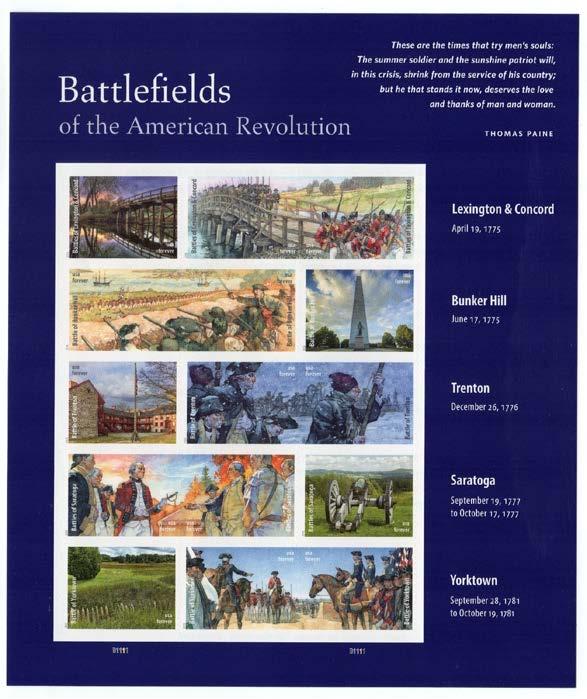
#???? Battlefields of the American Revolution B1111 ‡ ‡ LL LR 2r x 2c 1,2,3,4*
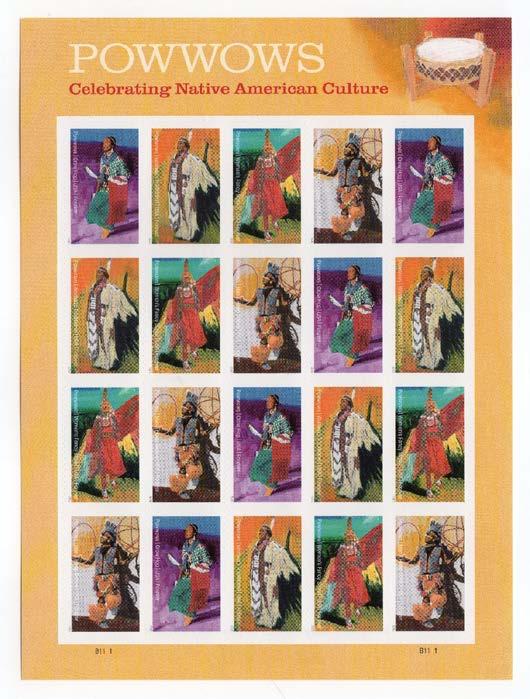
#???? Powwows B1111 ‡ ‡ LL LR 2r x 2c 1,2,3,4*

3
#???? Dahlias Coil P1111
#???? Dahlias Booklet P1111

3 #???? Goodnight Moon B1111 UL UR LL LR 3r x 2c


COORDINATORS: Members are invited to report their findings to the appropriate coordinator.
All issues through 1980
Sheet stamps after 1980
Kim D. Johnson
310 E N 3rd Street
Georgetown, IL 61846
Jim Cochrane P.O. Box 2009
Great Bend, KS 67530
Coil stamps after 1980 Jill Ambrose PO Box 54622 Cincinnati, OH 45254
Booklet stamps after 1980 Michael O. Perry P.O. Box 1194 Rainier, OR 97048
This monthly report is used to update the Durland Standard Plate Number Catalog.
United States Stamp Society
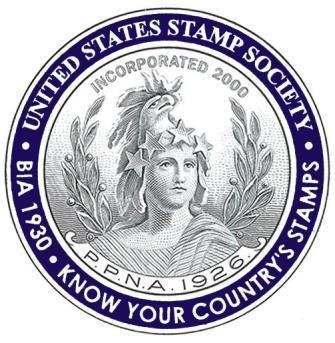
Or by mail to: USSS Executive Secretary, P.O. Box 1602, Hockessin DE 19707-5602
I hereby apply for membership in the United States Stamp Society, Inc. and have enclosed payment for initiation fees, dues and a subscription to The United States Specialist based upon the remittance schedule below. I understand that the full amount of my remittance will be returned if my application is not accepted.
Name ______________________________________________
Address _
City State _____________ Zip+4
Email (required)
Contact Phone (optional)
References
Note: Current APS members need only provide a membership number. Others should provide a full name and address of two philatelic references.
APS No _
Or Philatelic Reference #1 _________________________________________________________________
Address _________________________________________________________________________
Or Philatelic Reference #2 _ Address _________________________________________________________________________
Signature of Applicant _____________________________________ Date _________________
Remittance Schedule (Online via PayPal or Credit Card)
Amounts include dues and postage prepaid for monthly journal for USA addresses only; North America add $8.00, other countries $30.00 in US funds. Make checks payable to United States Stamp Society or USSS.
Jan-Feb-Mar $25.00
Apr-May-June $20.00
July-Aug-Sept $15.00
Oct-Nov-Dec $30.00*
*Includes 12 months of following year
Amount Enclosed __________________
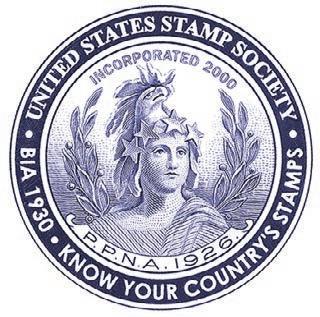
Report of the Executive Secretary
APPLICATIONS RECEIVED FOR APRIL 2025
17610 Matthew Carlson, Gresham, OR 17611 Rich Sandler, Tamarac, FL
17612 David T. Robinson, Rochester, NY
17613 Douglas Chapman, Sioux Falls, SD 17614 Cesar Carranza, South Gate, CA
APPLICATIONS PENDING
17606-17609
NEW MEMBERS
17604-17605 REINSTATED
16705 Mike Stern
16984 Francisco De La Torre
17006 Russ Liachoff
17483 Larry Hanson
17487 Mike Shofner
17527 Michael Brookbank
17531 Jamie Yakes 17554 Jean Lhuillier DECEASED
15881 Anthony F. Dewey
The U.S. Philatelic Classics Society is a not-for-profit collector organization exclusively devoted to 19th century United States stamps and postal history. Our quarterly Chronicle is widely recognized for presenting new scholarship and discoveries. For membership information and much more, find us at: www.uspcs.org.
TOTAL MEMBERSHIP March 31, 2025 1302 DONATIONS (received outside of annual dues cycle)
Leslie Butler
USSS Donations via PayPal
Recently, one reinstating member observed that our PayPal information is not easily located in The Specialist nor on our website. Renewal links and book orders automatically link to our PayPal account, but you may also send payments to USSS directly, and add a footnote to comment on the purpose, e.g. Renewal, Donation or Book-Durland. The PayPal account address is usorders@usstamps.org
Classified Advertising
USSS MEMBERS are entitled to two free ads of up to 40 words each year. Other ads are 10¢ a word, payable in advance. For 6 insertions, take a 5% discount; for 12 insertions, take a 10% discount. Ads with [1144] at the end expire with this issue. Make checks payable to USSS. Send copy and check to The United States Specialist, 9038 E. 25th Dr., Denver CO 80238. Free member ads may be emailed to: editor@usstamps.org. Emailing ads saves substantial time for you and the Editor and avoids errors .
WANTED
BUYING IMPERF FARLEYS with GUM. ALL offers welcome! Frank P Geiger Senior - APS Life since 1968 and ASDA since 1974. Phone: 787-6896879–FrankPGeigerSr@gmail.com–PO Box 3442–Pinehurst, NC 28374. [1150]
WANTED—PAYING TOP DOLLAR FOR C-13, C-14 and C-15 singles, both mint/used. Also interested in multiples, flight covers, Zeppelin-related posters, advertisements, etc. Graf Zeppelin specialist. Rob Lehmann email: diecasttoys@yahoo.com or call: 240422-0118. [1150]
WANTED TO PURCHASE #1053 HAMILTON $5 Commercial Usages. Especially need use to foreign destination. Also doing a survey so scans appreciated. Doug Weisz weiszcovers@gmail.com, 773-9144332. 33 W Ontario St. #48A Chicago IL 60654. www.douglasweisz.com [1152]
SEEKING USS INDEPENDENCE STAMP similar to Scott #4703 USS Constitution stamp. Bernard Wojnowski; 64 Mariner Rd., Vineyard Haven, MA 02568. [1155]
WANTED: 730-1, 735, 750-1 USED WITH 1930’S cancels. Warren Mullisen, mullisen@sbcglobal. net [1144]
WANTED BUY/TRADE: MNH BUREAU precancels. Definitive sheet stamps, coils—1923 through Americana series, Scott 581//1816. No Christmas, airmails, transportation, or later. Singles, blocks, plate blocks, sheets, coil pairs, line pairs, rolls. Herman Axelrod, POB 3161, Boulder, CO 80307 hermanax@comcast.net 303-499-9264 (no texting) [1144]
WANTED: YOUR DAV (DISABLED AMERICAN Veterans) reply covers, unused or used, for an exhibit. Interested in acquiring any amount—a few or a lot. Admit it, you’ve wanted to get rid of these for years. Now’s your chance! Send info to: RBajenski@hotmail. com or text 713/826-5178 with details. [1144]
WANTED: US NEWSPAPER ADVERTISING covers, corner cards, 1850-1925. Dailies, weeklies, big cities, small towns. (No magazines, book publishers, bookstores, newsstands.) Prefer English-language,
general interest newspapers (picky about agricultural, religious, non-English, etc., papers). Dane Claussen, danes.claussen@gmail.com [1144]
WANTED: CE2 TYPE 1C PLATE block MNH preferred. Send picture and price to whs1963whs@yahoo.com [1145]
RESEARCHER SEEKING OWNER OF 10-cent Motorcycle special delivery die proof that was presented to President Harding in 1922. Jerry Katz email: jerryakatz@aol.com [1144]
WANTED To BUY: COLLECTIONS accumulations, or duplicates of United States Plate number, mail early, ZIP code and copyright singles. Roger McDonald, 4210 Bratton Road, Corpus Christi, TX 78413. Also interested in buying United States plate number blocks. [1145].
FOR SALE
SEND $3.00 FOR A TYPED LIST OF HIGH QUALITY stamps. $5.00 off first order. Satisfaction guaranteed. Reed Roholt, PO Box 1006, Beaver UT 84713[1144]
THESTAMPNUT.COM CURRENTLY HAS over 14,325 listings and as always > Better Prices, Better Customer Service, Better Order Processing, Better Packaging and Flat Rate Shipping too! From Scott #1 to recent issues ~ MNH or Used, All Formats * APS, USSS, IPDA * 845-791-0950 [1144]
NAPEX BOOTH #22, JUNE 6-8 GASS BOOTH #326, August 14-17 one stop shopping US, B-O-B, postal history, stationery & BNA Lewis Kaufman 845-7948013 email: kerik1@aol.com [1144]
Index of Advertisers
Armen Hovsepian (www.USatFACE.com)........................................ 249 Boston 2026 (www.boston2026.org) ........................................252 Lewis Kaufman (kerik1@aol.com) ................................................... 261 Mountainside Stamps, Coins and Currency (www.mountainsidestampsandcoins.com) ........ 261 Precancel Stamp Society (www.precancels.com). 263 Richard Friedberg (www.friedbergstamps.com). ..............................283
Robert A. Siegel Auction Galleries (www.siegelauctions.com) 282
Scott A. Shaulis (www.shaulisstamps.com) .................................. 249
U.S. Philatelic Classics Society (www.uspcs.org) 287
United States Stamp Society (www.usstamps.org) 283, Covers
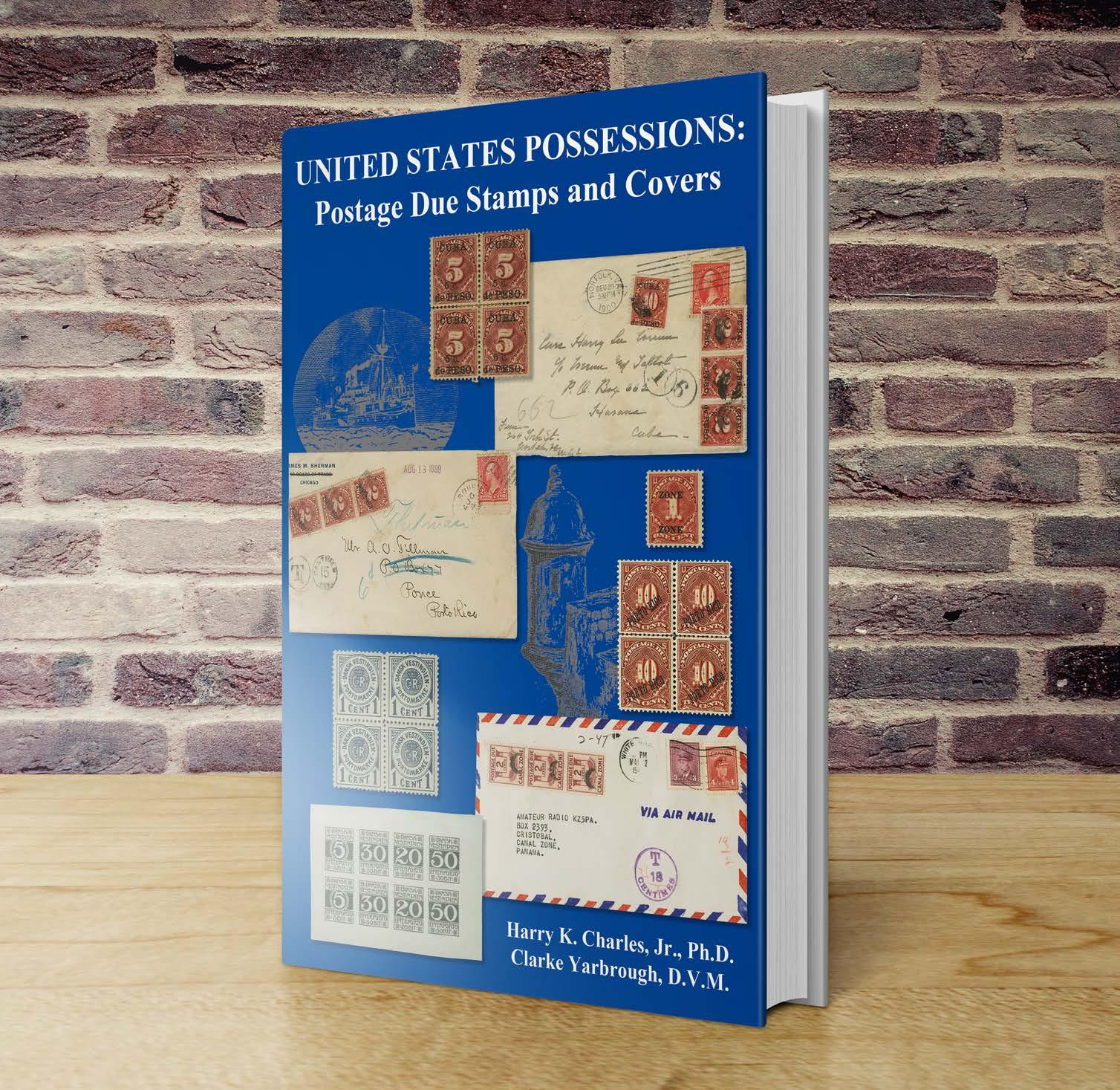
United States Possessions: Postage Due Stamps and Covers presents the story of Postage Due stamps used in the major possessions or territories of the United States. Written from a stamp collector’s perspective, the authors address the challenge of identifying the myriad of Possession Postage Due stamps by concentrating on stamp identification while also covering the Postage Due issues of Cuba, the Danish West Indies, Puerto Rico, the Panama Canal Zone, the Philippines and more.
In addition to the text, the monograph contains over 300 illustrations and five appendices which provide information to supplement and further explain key points. In many cases, the information presented is new or, if previously reported, organized in a new manner to help the reader understand the complexity of the Possession Postage Dues.

United States Possessions: Postage Due Stamps and Covers
Hard cover, 352 pages, 6-in × 9-in.
Member Price: $39 US postpaid Non-Member Price: $43 US postpaid Purchased online at: www.usstamps.org/store/ or by mail to: Executive Secretary, P.O. Box 1602, Hockessin, DE 19707-5602


United States Stamp Society
The 2020 edition the Durland Standard Plate Number Catalog provides the most comprehensive research source for plate number information on United States postage and revenue stamps, including tax-paid revenue stamps, with listings for overprinted Possessions postage, Allied Military government stamps and other back-of-the-book stamps, dummy and test stamps, MDI "Blue Cover" booklets and partial plate numbers on booklet and coil stamps.
2020 Edition of the Durland Standard Plate Number Catalog 448 pages available in Perfect Bound or Spiral Bound format. Member Price: $40 US plus shipping Non-Member Price: $45 US plus shipping
Order Online at: www.usstamps.org/store
